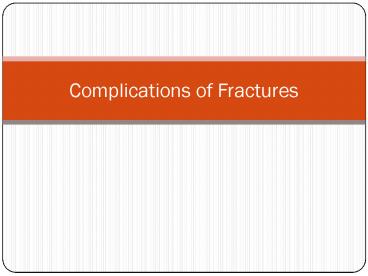Complications of Fractures - PowerPoint PPT Presentation
1 / 22
Title:
Complications of Fractures
Description:
Is an area of the body encased by bone or fascia ... Fasciotomy (surgical decompression of the fascia) Wound left open 3-5 days ... – PowerPoint PPT presentation
Number of Views:3957
Avg rating:2.0/5.0
Title: Complications of Fractures
1
Complications of Fractures
2
Fracture Healing
- Weeks to months are required for most fractures
to heal - Adequate reduction
- Adequate blood supply
- Type of fracture
- Flat bones heal rapidly
3
Complications
- Two Categories
- Early
- Shock, fat embolism, DVT, PE, and infection
- Delayed
- Delayed union, reaction to internal fixation
devices,
4
Shock
- Hypovolemic shock from hemorrhage
- Visible and non-visible blood
- Bone is vascular, large quantities of blood can
be lost due to trauma - Treatment
- Stabilizing fracture to prevent further
hemorrhage - Restoring blood volume and circulation
- Relieving pain
- Protection from further injury
5
Fat Embolism
- Fat emboli develops after fx of long bones,
pelvic bones, multiple fx or crush injuries. - Occurs most frequently in ages 20-30 years and
elderly adults (hip) - Fat globules diffuse into the vascular
compartment - Emboli occlude small vessels that supply the
lungs, brain, kidney and brain
6
Clinical Manifestations of Fat Emboli
- Hypoxia
- Tachypnea
- Tachycardia
- Pyrexia
- Dyspnea, crackles, wheezes
- Precordia chest pain
- Cough
- Large amount of white sputum
7
Prevention and Management
- Immediate immobilization of fractures
- Adequate support for fractured bone during
turning and positioning - Maintenance of fluid and electrolyte balance
- Monitor high risk patients
- Support resp. system
8
Prevention and Management
- Controlled volume ventilation
- To prevent and treat PE
- Corticosteroids
- Inflammatory lung reaction
- Cerebral edema
- Vasopressors
- To support cardiovascular function
- Prevent hypotension
- Shock
- PE
- Accurate IO
9
Prevention and Management
- Analgesics
- Morphine for pain
- Benzodiazepine midazolam, (Versed)
- To relieve anxiety
- Calm reassurance
- To allay apprehension
10
Compartment Syndrome (CS)
- Is an area of the body encased by bone or fascia
- Is a painful condition that results when pressure
within the muscles builds to dangerous levels.
This prevents nourishment from reaching nerve and
muscle cells. - Develops when pressure in a compartment is
greater than the normal
11
Three Types of Compartment Syndrome
- Acute Compartment Syndrome
- A sudden and severe decrease in blood flow to the
tissues distal to the injured area ? ischemic
necrosis - Chronic Compartment Syndrome
- Characterized by pain and swelling caused by
exercise. - Crush Compartment Syndrome
- From a crushing injury
12
Compartment Syndrome Symptoms
- Deep, throbbing, unrelenting pain
- Caused by
- Reduction in size of the muscle compartment ,
- Because the enclosing fascia is to tight
- Cast or dressing to restrictive
- Edema or hemorrhage
- The classic sign of acute compartment syndrome is
pain, especially when the muscle is stretched.
13
Compartment Syndrome Symptoms
- The pain may be intensely out of proportion to
the injury, especially if no bone is broken. - If the area becomes numb or paralysis sets in,
cell death has begun and efforts to lower the
pressure in the compartment may not be successful
in restoring function.
14
Assessment and Diagnosis
- Frequent assessment of neurovascular function
after a fracture - Focus on the 5Ps
- Pain, paralysis, parethesias, pallor
pulselessness
15
Assessment and Diagnosis
- Sensory deficits
- Deep throbbing pain, escalating pain ?s passive
stretching. - Parethesia, (burning or tingling sensation and
numbness) nerve involvement - Motion Deficits
- Moving fingers or toes distal to the problem
- Peripheral Circulation
- Assessing color, temperature, cap refill time,
swelling and pulses
16
Neurovascular Checks
- HAVE I DOCUMENTED
- Temperature
- Coldness of an extremity distal to the injury,
combined with pallor or duskiness indicates
pressure on the artery and requires immediate
medical intervention - Movement
- Test motor function by having patient move
extremity distal to the injury
17
Neurovascular Checks
- Color
- Pallor suggests poor arterial perfusion and
cyanosis suggests venous congestion - Perfusion
- (Capillary Refill Time) CRT gt than 2 seconds
suggests decreased arterial capillary perfusion - Loss of pulse of an extremity distal to the
injury requires immediate medical intervention
18
Neurovascular Checks
- Pulses
- Palpate pulses distal to extremity, they should
be full and strong. - Pain assessment
- Should be done on admission and every 4 hours
thereafter, unless more frequent assessment is
indicated
19
Wick Catheter
- Inserted into a muscle
- Measures compartmental pressure
- Normal pressure 8 mm Hg or less
20
Medical Management of CS
- Notify physician immediately if neurovascular is
compromised - Elevation of extremity
- Release of restrictive devices (dressings or
cast) - Fasciotomy (surgical decompression of the fascia)
- Wound left open 3-5 days
- Covered with moist sterile saline dressings
- Affected extremity splinted and elevated
- ROM q 4-6 hours
- Skin grafts in 3-5 days
21
Complications
- After a fasciotomy
- Avascular necrosis of the bone (AVN)
- Infection
- DVT
- PE
- Delayed union, malunion and nonunion
22
THE END !

